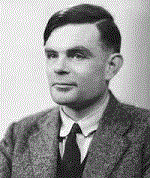The life and achievements of Alan Turing – the mathematician, codebreaker, computer pioneer, artificial intelligence theoretician was born 100 years ago on 23 June 1912. Turing was born into a world that was very different, culturally and technologically, yet his contribution has never been more important.
Turing was born into a world that was very different, culturally and technologically, yet his contribution has never been more important.
His is a story of astounding highs and devastating lows. A story of a genius whose mathematical insights helped save thousands of lives, yet who was unable to save himself from social condemnation, with tragic results. Ultimately though, it’s a story of a legacy that laid the foundations for the modern computer age.
In 1936, while at King’s College, Cambridge, Turing published a seminal paper On Computable Numbers which introduced two key concepts – “algorithms” and “computing machines” – that continue to play a central role in our industry today.
He is remembered most vividly for his work on cryptanalysis at Bletchley Park during World War II, developing in 1940 the so-called electro-mechanical Bombe used to determine the correct rotor and plugboard settings of the German Enigma encryptor to decrypt intercepted messages.
It would be hard to overstate the importance of this work for the Allies in their conduct of the war.
After the war, Turing worked on the design of of the Automatic Computing Engine (Ace) at the National Physical Laboratory (NPL) and in 1946, he delivered a paper on the design of a stored program computer.
His work was contemporary with another giant in computer science, John von Neumann, who worked on the Electronic Discrete Variable Automatic Computer (Edvac).
Ace and Edvac were binary machines and both broke new conceptual ground with the idea of a program stored in a memory that drove the operation of the machine.
Storing a program in the computer’s memory meant that the program could alter itself, opening up remarkable new computing vistas.
Remarkably, the Ace designs found their way into the Bendix Corporation’s G-15 computer by way of Harry Huskey who had spent 1947 working on the Ace project at NPL.
The first Bendix G-15 ran in 1954, the year that Alan Turing tragically died.
In 1949, Turing became the deputy director of the Computing Laboratory at the University of Manchester where he focused on the software needed to drive the Manchester Mark 1 stored program computer. In 1950, he published a paper entitled Computing Machinery and Intelligence, in which he explored the notion of artificial intelligence.
In this paper, he posed the so-called Turing Test in which an artificial intelligence would be judged intelligent if another human could not tell the difference between the responses of a human and the artificially intelligent machine.
